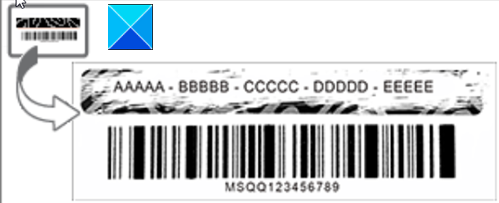Many software programs at the time of installation require users to enter a Product key. It contains both letters and numbers, an alphanumeric code combination of varying lengths. The key verifies the legitimacy of the product by assuring software developers that the copy of their software was legally purchased and is not a counterfeit product.

Having said that, a buyer can be left confused if he does not have an understanding of different types of Microsoft Product Keys and what do they mean. Read the complete post to know the difference between these keys.
Types of Microsoft Product Keys
Following are the types of Microsoft Product keys:
- CUS
- MAK
- KMS
- VL 1
- RTL
- STA
- OEM
- AAA
- AAL
- AAM
- AV1
- AV2.
Let’s cover these product keys alongside their brief description.
1] CUS
Better known as a custom key, it requires special actions to activate or install. Custom keys offer special actions or information to activate or install the product.
2] MAK
Volume MAK (Multiple Activation Key) product keys are volume license keys that are not-for-resale. They are issued by organizations for use on client computers associated in some way with the organization. They are used to activate a specific number of devices. The count is pre-configured as a deal between Microsoft and Enterprise.
3] KMS
Enterprise is given KMS (Key Management Service?\) Volume Licensing key using which they need to configure an in-house server using Microsoft’s Software Licensing Service.
Read: What are KMS and MAK Volume Licensing Keys?
4] VL 1
This is a VA 1.0 key. These are multiple activation keys, like a MAK.
5] RTL
The retail product key is something a customer receives when he purchases a Full Packaged Product (FPP), a.k.a a boxed copy of Windows from a retail merchant or online via the Microsoft Store.
Read: How to tell if Windows license is OEM, Retail, or Volume?
6] STA
It refers to static activation keys provided for products that do not require activation. They can be used for any number of installations. This setup key is mainly used to bypasses the activation step.
7] OEM
OEM Key enables single or multiple activations om specific computers. It’s a digital product key (DPK) that is installed on the motherboard BIOS during the manufacturing process. Windows activate automatically the first time the computer is connected to the Internet.
8] AAA
This retail key permits single activation only.
9] AAL
It’s a lab use key for AA programs and allows multiple activations.
10] AAM
These are multiple activation keys for AA program customers.
11] AV1
Enables multiple installations for AA programs.
12] AV2
This key is for Academic Alliance programs.
Read: How to check if the Windows Key is Genuine or Legit?
Microsoft product keys are designed to be compatible with the hardware, software, and peripherals you already own. Moreover, always-enabled updates help you get the latest features and security for the supported lifetime of your Microsoft Products.
Also read: Types of Retail Microsoft Office Product Keys.
Leave a Reply